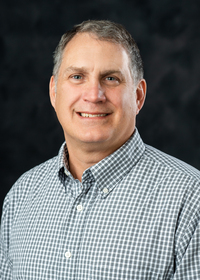Information Possibly Outdated
The information presented on this page was originally released on January 15, 2004. It may not be outdated, but please search our site for more current information. If you plan to quote or reference this information in a publication, please check with the Extension specialist or author before proceeding.
MSU mobile poultry lab gives unique opportunity
MISSISSIPPI STATE -- It looks like an average camper trailer from the outside, but a new food safety lab at Mississippi State University lets veterinary researchers find ways of reducing bacteria in poultry.
After the first year of a three-year grant in excess of $1 million, MSU College of Veterinary Medicine professors Drs. Robert Wills and Hart Bailey have begun collecting samples from poultry farms across Mississippi and three other states. They will sample chickens from 72 flocks four times each to determine the best point to concentrate treatment efforts to reduce Salmonella and Campylobacter in the animals.
"We can measure Salmonella and Campylobacter in feed, chicks, adults, litter and the air -- all over the continuum -- but no one knows how they relate to the final outcome," said Wills, CVM associate professor. "We want to find the most efficient time to intervene in the production process to reduce Salmonella and Campylobacter in the final product."
Along the production chain, Bailey said researchers plan to divide the poultry production and processing continuum into four segments: breeder-hatchery, grow-out, transportation from the farm to the plant and processing.
They will evaluate bacterial levels at the hatchery, the last week before leaving the production house, when the birds arrive at the processing plant, before the chill tank and exiting the chill tank.
"If a primary point of contamination can be identified, researchers can focus on that area to reduce the risk of Salmonella," Wills said. "We can make a lot of commonsense assumptions, but until we test them, any decisions we make can be wasteful and nonproductive."
Bailey said the need for this sort of research increased when the Food Safety and Inspection Service implemented the Hazard Analysis Critical Control Point, or HACCP, regulations in 1998. Campylobacter is not regulated yet and testing is difficult, but it is typically more common on broiler carcasses than Salmonella.
"We're trying to determine the best place within the chain to do intervention methods," said Bailey, CVM associate professor. "We will test the samples for Salmonella, and we'll send samples to Dr. Allen Byrd at the USDA Agricultural Research Service's Food and Feed Safety Research Laboratory in Texas to test for Campylobacter."
Wills and Bailey are spearheading the research effort funded by the U.S. Department of Agriculture. In addition to scientists and personnel from MSU-CVM, the multidisciplinary research team includes people from MSU's Extension Service, the USDA Agricultural Research Service and two different poultry companies, Sanderson Farms and Peco Farms, operating in nine processing plants
"We will examine risk factors in management decisions, in the environment and in the production process," Wills said. "Management decisions include issues such as stocking density, how many flocks are on the litter before it is changed and how much time passes in between flocks. Environmental issues include things like the type of ventilation or the type of water dispensers."
The samples will be taken and initial processing begun in a mobile lab -- a used and converted 28-foot recreational vehicle Wills and Bailey bought with funds from the food safety grant. Wills said the idea of having a mobile lab came from his days as a master's program student about 25 years ago at the University of Tennessee.
"We were out in the fields for a week at a time, and having the lab right there would have made taking and testing samples much easier and faster," Wills explained. "When Dr. Bailey and I started thinking about this research project, we agreed a mobile lab would be very beneficial to the research project."
Without the mobile lab, which has been refurbished and houses an incubator cabinet, refrigerator, sink and work areas, Bailey said they would be conducting sample preparation from the back of a pickup truck and transporting them to his CVM lab. Another benefit is that the researchers will have a "home base" of sorts during their stays at different processing plants.
"Sometimes we have to get to a plant and start taking samples at 11 p.m., and we'll be there for eight or 10 hours," Bailey said. "With the mobile lab, we'll have a convenient location to collect and test samples."
Bailey credits the poultry industry's willingness to improve their methods as a catalyst for this type of food safety research.
"Identifying the factors that have an impact on the occurrence of the bacteria in broilers will benefit the poultry industry, allowing them to continue to meet food safety standards and produce a good quality product," Bailey said, adding that heat readily kills these bacteria, and the final defense against any food-borne illness is proper handling by the end user.
He added that with the increased awareness concerning homeland security, one new emphasis in veterinary medicine is in the area of crisis management and disaster response. The mobile lab will also be a resource that could allow CVM to address these issues in the future if on-site response is ever needed.
Contact: Dr. Hart Bailey, (662) 325-7726





